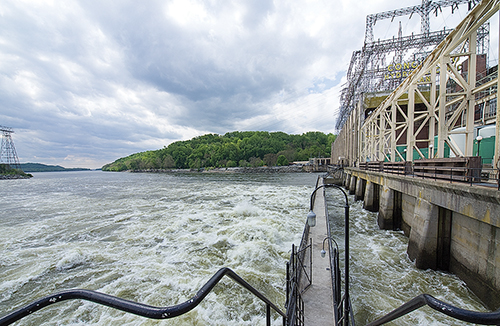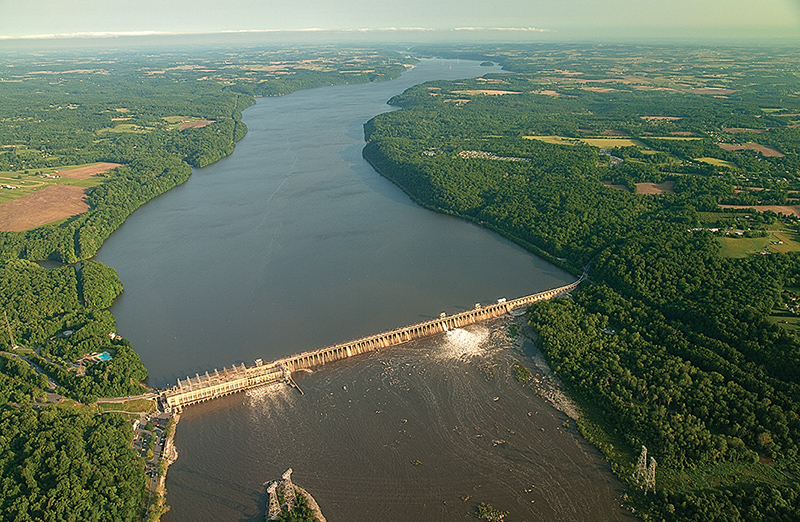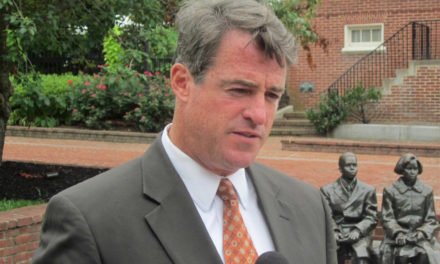By Karl Blankenship
Bay Journal
The Chesapeake cleanup effort is facing major headwinds that threaten the region’s longstanding goal to implement by 2025 all of the actions needed to restore the Bay’s health.
Draft figures presented to state and federal officials in December show that the combined impact of growth, climate change and the filling of the Conowingo Dam reservoir offset much of the nitrogen reduction efforts undertaken since 2010, when the most recent Bay pollution control plan was put into place.
As a result, officials left the December meeting agreeing that they would write plans to offset the increased nutrient loads, but did not clearly commit to fully implementing those actions, at least for Conowingo and climate change, by the original 2025 cleanup deadline.
“We’re going to continue to talk about that in February,” said Ben Grumbles, secretary of the Maryland Department of the Environment. “That is a big number, there is no doubt about that.”
Grumbles, who chaired the meeting of the Bay Program Principals Staff Committee, which includes state agency heads and senior federal officials, said it was important to get agreement among the states on the path forward, but added he was “not supportive of kicking the can down the road.”
Midpoint assessment of cleanup
The numbers emerged from the state-federal Bay Program’s “midpoint assessment” of cleanup efforts — 2018 is the midway point between 2010, when the latest Bay cleanup goals were set, and the 2025 deadline for implementing plans to reach those goals.
Through the multi-year midpoint assessment process, state and federal officials reviewed new science, adopted new computer models for assessing the movement of nutrients through the watershed and their impact on the Bay, and are revising nutrient reduction goals needed to restore clean water throughout the Chesapeake.
Based on that new information, each state is to update its watershed implementation plan later this year, detailing the actions that will be needed to achieve their share of the cleanup. Those actions include such things as upgrading wastewater treatment plants, installing new controls to capture stormwater from developed areas or planting streamside forest buffers or cover crops to soak up excess nutrients from farmland.
The region faces a daunting task. Through 2016 — the most recent figures available — the region was less than a third of the way to meeting its 2025 goal for reducing nitrogen. The vast majority of the shortfall, though, is in Pennsylvania.
Dam, climate change offset Bay progress

Because all of the Bay states benefited when the Conowingo Dam was trapping nutrients, they have all agreed to contribute a portion of their federal Bay cleanup funding to help fund pollution control solutions. Contributions will also be sought from Exelon, the dam’s owner. Photo by Dave Harp, Bay Journal
While states remain committed to meeting their original 2025 cleanup obligations and to offsetting the impacts of new growth between now and then, they balked at firmly committing to offset the impacts of Conowingo and climate change which, factored together, offset much of the nitrogen reduction efforts taken since 2010.
Conowingo Dam once captured a significant portion of the nutrients that came down the Susquehanna River, the Bay’s largest tributary — and largest source of nutrients. Nutrients, trapped in sediment that accumulated behind the dam, were effectively cut off from their path toward the Bay. Recent studies, though, have shown the reservoir behind the dam is now filled with sediment, and most nutrients simply flow past it.
State officials at the December meeting agreed to develop a plan for additional nutrient reductions to offset the impact of Conowingo, but they did not commit to fully implementing it by 2025.
Climate change increases nutrients in the Bay because more rainfall and greater storm intensity drive a larger amount of nutrients off the land and into streams. The original Bay cleanup goals were based on modeling that assumed steady climate conditions from the early 1990s through 2025. Instead, average precipitation during that period is expected to increase by slightly more than 3 percent, increasing the expected size of the climate-related nutrient load.
Officials caught off guard

A pickup truck plows through a high tide on, appropriately, Water Street in Cambridge. So called sunny day flooding occurs there during the time of full moon or with winds favorable to pushing water up the Choptank River.
State officials were caught off guard by the magnitude of the climate change numbers, which boosted the estimates of nitrogen reaching the Bay by nearly 4%. In addition, they expressed concern that changing climate patterns, such as increased rainfall, would likely change the effectiveness of some nutrient control practices. Stormwater ponds may not be able to handle more intense storms, for instance, while increased flooding could affect others.
After extensive debate, officials agreed that their watershed implementation plans would generally describe how the states will address nutrient loads from climate change, but delayed quantifying the needed amount of reductions until 2021.
Delaying the inclusion of numeric goals was intended to give scientists more time to refine their estimates and to identify which nutrient control practices are most likely to withstand changing climate conditions.
“We need to get a better understanding of what those practices are and where they need to go,” said Nicki Kasi, who is overseeing development of Pennsylvania’s nutrient reduction strategies for the state’s Department of Environmental Protection. “Once we understand where they need to go to be effective, then we can take another look at that. This is all early draft.”
Grumbles said the states are “all agreeing that we do need to factor it in, and we need to have a strong approach to it. But it is going to take some time to get the numbers right.” He pledged to keep the issue “on the front burner.”
Environmentalists disappointed
Beth McGee, director of science and agricultural programs with the Chesapeake Bay Foundation, said she was “really disappointed” that the states would not commit to including climate-related nutrient reduction goals in new cleanup plans, even if it meant those nutrient reductions could not be achieved until after 2025.
“You can’t pick and choose what science you like just because climate change turned out to be a bigger number than we anticipated,” she said.
David Flores, climate adoption policy analyst at the nonprofit Center for Progressive Reform, said the decision to leave numbers out of the planning process was “outrageous” and that it would reduce the urgency to address the problem. “They are not even advancing a reasonable rationale for why they shouldn’t just acknowledge the numbers,” he said. “No one is arguing there is not some load of pollution that is attributable to climate change.”
On the issue of Conowingo, though, McGee praised the framework being developed to address the impacts from the dam. Under the emerging plan, all of the states in the watershed will steer a portion of their federal Chesapeake Bay restoration grants to fund implementation of the Conowingo plan, and Maryland will seek contributions from Exelon Corp., the dam’s owner, as part of its relicensing agreement.
It’s unlikely, though, that actions to offset Conowingo’s impact will be fully implemented by the original cleanup deadline. “I think we are kidding ourselves if we think we are going to do that by 2025,” McGee said. At the same time, she added, “we certainly don’t want to see it kicked too far down the road.”
The joint funding would also help Pennsylvania, the state faced with implementing the majority of the nutrient reduction practices needed to offset increased nutrients from Conowingo.
“The devil is going to be in the details to see how that plays out, but I’ve been optimistic as far as to the direction it is going,” said Kasi of Pennsylvania’s DEP. “It is a realistic way of moving forward together.”
Excess nutrients foul the Bay by spurring algae blooms that cloud the water, blocking sunlight to underwater grasses, which provide shelter and food for fish, shellfish and waterfowl. When the algae die, they sink to the bottom and decompose in a process that draws oxygen from the water, creating oxygen-starved dead zones.
The Bay cleanup plan — formally known as the Chesapeake Bay Total Maximum Daily Load, and often referred as the Bay’s “pollution diet”– sets nutrient levels intended to clear the Chesapeake’s water and ensure that enough oxygen is available to support everything from bottom-dwelling worms to the striped bass that swim along the surface.
But several places, all of which are in Maryland, would fail to meet clean water goals even when all the nutrient reductions required under the TMDL were achieved, computer models showed. In those places, Maryland and the U.S. Environmental Protection Agency approved temporary variances, which allow the state’s water quality standards to be exceeded.
McGee said she was open to extending the time frame for fully implementing actions to offset Conowingo and climate change impacts beyond 2025 because, if the needed actions seem unachievable, states may instead push to expand variances or make other decisions that would weaken the clean water goals.
“We don’t want to lower the bar,” she said. “We want to keep the bar the same but maybe take a little bit longer to get over it.”
Bay Journal is published by Bay Journal Media, a 501(c)(3) nonprofit, to inform the public about issues that affect the Chesapeake Bay. A print edition is published monthly and is distributed free of charge. News, features and commentary are available free online at bayjournal.com. MarylandReporter.com, also a 501(c)(3) nonprofit news organization, is partnering with the Bay Journal by publishing one of its articles every Friday.






Recent Comments